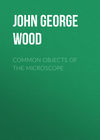Buch lesen: «Nature's Teachings», Seite 22
CHAPTER II.
CRUSHING INSTRUMENTS.—THE NUT-CRACKERS, ROLLING-MILL, AND GRINDSTONE.—PRESSURE OF ATMOSPHERE.—SEED DIBBLES AND DRILLS
Importance of Leverage in Crushing Power.—Nut-crackers a Lever of the Second Order.—The Chaff-cutting and Tobacconists’ Machines.—Jaws of various Animals.—The Wolf-fish or Sea-wolf.—The Rolling-mill and its Action.—Gunpowder-mills and Granulating Machine.—The “Jacob’s Ladder.”—The Mangle and its various Adaptations.—The Grindstone.—Primitive Grindstones of the Savage Races.—The Kafirs and the Inhabitants of Palestine.—Ceasing of the Millstone.—“Facing” of Millstones.—Tusk of the Elephant and its Structure.—Its Facings always preserved.—Power of Self-renewal.—Pressure of Atmosphere.—The Napier Coffee Machine.—The Cupping Instrument.—The Pneumatic Peg.—The Magdeburg Hemispheres.—Plane Surfaces of Glass or Metal.—Suckers of the Cuttle-fish.—Foot of the Water-beetle.—The Limpet.—The Star-fish and its Mode of Progression.—The Sucking-fish and the Fables connected with it.—Its real Structure.—Modification of the Dorsal Fin.—The Gobies and Lump-fish.—The Gecko and Tree-frog.—The Lampern and the Medicinal Leech.—Seed Dibbles and Drills.—Labourers versus Machinery.—Natural Dibble of the Grasshopper.—The Daddy Long-legs.—Drills and Dibbles of the Ichneumon-flies.—A wonderful Specimen from Bogotá.—The Pelecinus and its Mode of laying Eggs.
Crushing Instruments
AS we are on the subject of leverage, we will take some examples of levers in Art and Nature, without, however, even attempting to exhaust the topic.
On the right hand of the illustration is shown a very familiar example of a lever, namely, nut-crackers, with a nut between them. This useful implement is simply an adaptation of levers of the second kind, the power being represented by the human hand, the weight by the nut, and the fulcrum being the joint of the instrument.
The common chaff-cutter, which is worked by hand, is another familiar example of this kind of lever, and so is the knife used by tobacconists in cutting cake Cavendish into threads, and by druggists for similar purposes. In these instruments the point of the knife is jointed to some fixed object, and becomes the fulcrum; the hand of the cutter supplies the power, and the weight is the object which is being cut. It will be seen that, by increasing the length of the handle, very great power can be obtained.

Exchanging the power for weight, we have in the common tongs, whether used for the coals or for sugar, a leverage of a similar character, the weight moving over a greater space than the power. A good example of this is to be found in the deltoid muscle of the human arm. The muscle, which furnishes the power, contracts about an inch, and, so doing, moves the hand over some forty inches of space. It has been well stated that if a man is able to hold in his hand, and with extended arm, a weight of twenty-five pounds, the muscle must be exerting a power of forty times as great, i.e. about a thousand pounds.
There is little doubt that, in such Crushing Instruments as have been mentioned, the idea has been taken from the jaws of sundry animals. We know, for example, that with ourselves, if we desire to crack a walnut or a filbert in our teeth, we always put it as far back as possible, so as to make the leverage as powerful as possible. No one would ever dream of cracking a nut with his front teeth, an act which would be very much like that of trying to break a piece of coal by pinching it with the tongs.
The left-hand figure of the illustration represents part of the jaws of the Wolf-fish, or Sea-wolf, as it is sometimes called, and a very wonderful crushing machine it is. The Sea-wolf (Anarrhicas lupus), sometimes called the Sea-cat, or Swine-fish, is tolerably common on our coasts, and, as it sometimes attains a length of seven feet, and is proportionately stout and muscular, the power of its bite may be estimated. The fish in question feeds chiefly on crustacea and hard-shelled molluscs, and is therefore furnished with an apparatus which can crush their shells. Extremes meet. The Sea-anemones, which are mere films of animal matter, and can be torn in pieces with the finger and thumb, can seize, swallow, and digest a crab or an oyster in spite of the thick and strong shells in which they are enclosed. So can the Sea-wolf, and fishes of a similar character. But nothing intermediate can touch them, and it is curious to reflect that such opposite means should produce a similar effect.
On reference to the illustration, the reader will see how exact is the parallel between the Nut-crackers and the Sea-wolf’s jaws, both being worked on the same principle, and both being furnished with a series of projecting points, which are used for the purpose of preventing the escape of the object which is to be crushed. The terrible grasping power of the crocodile, the dolphin, and other predacious creatures can be explained on the same principle.
The Rolling-mill
We now come to another variation of the Crushing Machine, i.e. that in which the motion is constant, and not intermittent, as is the case with those machines which have just been mentioned.
Perhaps some of my readers may have visited those great iron-works in which huge masses of iron are rolled into plates of greater or less thickness, or are cut up into strips as easily as if they were butter.
The mechanism is in its principle simple enough. The cylindrical rollers are placed nearly in contact, and forced towards each other by mechanical means, such as levers, screws, or springs, or all three combined. These cylinders revolve in opposite directions, and, if any object be placed between them, they draw it through them, and present it on the other side in a flattened condition.

Many years ago, one of my schoolfellows, who had been brought up entirely under the care of some maiden ladies, was visiting a workshop, and must needs put his finger between two revolving rollers. Of course the hand was drawn between them, and simply squeezed flat. The machine was instantly stopped, and the hand extricated; and the strange thing was, that the crushed and shapeless hand afterwards recovered its full power, though not its shape, and was able to touch the keys of the piano.
The whole process of the Rolling-mill is singularly interesting, whether it be used for large or small objects.
Supposing that the grooved rollers of the illustration were cut across so as to present a number of points, it is evident that anything which got between them would be bitten to pieces, each piece being of a tolerably uniform shape.
This plan is now adopted in the granulation of gunpowder. After the future powder has emerged from the hydraulic press in the form called “press-cake,” it was formerly broken to bits with wooden or copper mallets, and then placed in a very peculiar kind of sieve. This was shaped like an ordinary sieve, but the bottom was made of cowhide, pierced with innumerable holes. A round pebble was placed in the sieve, and, when the latter was violently shaken backwards and forwards, the powder was driven through the holes by the pressure of the stone, and was afterwards separated into its various degrees of fineness.
I have only twice seen this process, and confess to have been in a very nervous state on both occasions. The sieve is whirled about with enormous velocity, and the pebble flies round as if it were a thing alive. Let but a broken needle or a fragment of stone get into the sieve, or even let the stone itself break asunder, and there will be an instantaneous explosion, which will hurl the house, the machinery, and the workmen into unknown regions.
Now, however, the mode of granulating powder is radically altered. There is a series of double cylinders, such as shown in the illustration, and each of them has the ridges cut into teeth in regular order. Thus the first set of rollers or cylinders merely bites the press-cake into convenient pieces, though seldom of the same weight.
The press-cake, thus bitten to pieces, is passed through a series of cylindrical sieves, each graduated with the utmost accuracy, and being turned by means of machinery. Being set on a slope, the powder runs by its own weight down them, and all those particles which cannot pass through the meshes are poured out untouched at the lower end.
The portions which are too large to pass the openings of the first sieve are then handed onwards by means of a machine called a “Jacob’s Ladder,” which consists of a series of little vessels or buckets strung on a tape, and revolving over a couple of wheels. The first set of buckets takes the coarsely bitten press-cake to the second set of rollers, the teeth of which are comparatively small. Thence it is passed over to a third set, and so forth, until it is delivered in any quality of grain which may be required.
The modern Mangle, again, affords a good example of this principle. The old obtrusive, costly, and cumbrous Mangle, which was nothing more than a heavy box of stones upon rollers, has given place to the modern system of duplex action in rollers, and one of the old Mangles is not easily to be seen, unless it be worked as a curiosity. In fact, it is nearly as obsolete as the spinning-wheel, which yet may be seen in some of our country villages, where scarcely one per cent, of the population has ever been in a town, and many of them, the women especially, make it their boast that they have never been beyond the outskirts of their village.
This clumsy machine is now replaced by the very simple invention which has been in vogue for some years, and which can not only release, but regulate, the pressure at any moment, by means of springs, levers, and weights. This machine is, in fact, exactly the same as that which is represented in the illustration, except that the rollers are quite smooth. They can be adjusted to almost any amount of pressure by levers and weights which are attached to the upper roller, and, when the linen has passed through them, it has undergone the double operation of wringing and mangling. This disposition of the rollers has long been anticipated in the jaws of the Skate which crush to pieces the shells of the whelks, periwinkles, &c., on which the creature feeds.
The Grindstone
Being on the subject of jaws and teeth as a mode of breaking to pieces objects which are placed between them, we will take those implements which grind to powder, or “triturate,” instead of breaking or flattening.
From the very earliest ages, and as soon as man had begun to discover the “staff of life,” the art of grinding naturally assumed an ever-increasing importance.
The first and most primitive mode of grinding corn and converting it into meal was that which was followed by Sarah, when she welcomed her husband’s guests, which we know, from internal evidence, was followed by the uncivilised races who formerly inhabited this island, and by many semi-savages of the present day.
Nothing could be simpler than the machinery used, and nothing could cause a greater waste of muscular power. Two stones were employed, a large one upon which the grain was placed, and a smaller which was held in the hands, and used for grinding the corn to powder, just as the painters of the last century used to grind their colours. The Kafirs of Southern Africa use this simple mill, and so exactly do they keep unconsciously to the customs of long-perished natives, that if one of their mills were buried for a few years and dug up again, it might be mistaken for one of the ancient “querns.” As the stone held in the hand was rounded, it naturally wore a rounded hollow in the lower stone, and this made the process of trituration easier. Perhaps some of my readers may have noticed that when a chemist makes up a prescription, and is obliged to reduce one of the ingredients to powder, he always does so by rubbing, and not by pounding, as is generally believed. He works the pestle round and round the mortar with a kind of twisting motion, and thus obtains a powder much too fine to have been produced by any amount of pounding.

The labour of this operation is necessarily very severe, and therefore the Kafir of the present day, as did his predecessors of the long-lost races, declines to do it himself, but hands it over to the women. In Palestine, as in other parts of the world, a simple mill has been invented, which takes away much of the labour, and, above all, releases the grinder from the obligation of leaning with her fall weight upon the upper stone. In this mill the stones are similar. The upper is moved backwards and forwards round a pivot, and the grain is passed between them by means of a conical aperture in the upper stone, which answers the purpose of our “hopper.”
In order to work this mill, two women are required, sitting opposite each other, with the mill between them, holding the same handle, and assisting each other in turning the stone backwards and forwards. No one who has not seen this operation can fully appreciate the force of the saying that “two women shall be grinding at the mill; the one shall be taken, and the other left.”
It is worthy of remark that, even at the present day, the custom of grinding corn is carried out in Palestine as it was so many centuries ago, and that it is repeated in Southern Africa among the Kafir tribes. In both parts of the earth the first sound of early morning is caused by the millstones of the grinding women, and the amount and duration of the noise afford a sure test of prosperity. Cessation of the millstones signifies adversity and a thin population, as has been said by a writer who lived not very far from three thousand years ago. Speaking of tribulation, he mentions that “the grinders cease because they be few, and that the doors shall be shut in the streets when the sound of the grinding is low.”
After awhile improvements were gradually introduced into the business of grinding, not the least of which was covering its surface with ridges, instead of leaving it entirely smooth, as it had been formerly. Millers of the present time know the value of these ridges, and the additional grinding power which this “facing” gives to a stone. One of these stones is represented in the illustration, so as to show the system on which the ridges and grooves are constructed.
Now, passing from Art to Nature, we find that the whole system of the millstone, its movement and its ridged surface, existed in the times when man had not yet come upon earth.
The reader is probably aware that among the tooth-bearing animals there are three types of teeth. First come the incisors, or cutting teeth, which occupy the front of the jaw, and find their fullest development in the rodent animals, such as the beaver, the squirrel, the rabbit, and the rat. Next them come the canine or piercing teeth, which are so highly developed in all the cat tribe. Lastly, there are the molar or masticating teeth, so called from a Latin word signifying a millstone, because their office is to grind food.
As it is with these last that we have now to treat, we will say nothing about the others.
The molar teeth find their greatest development in the Elephant, the structure of whose molars is exactly like that of our modern millstones. There is certainly one very great difference. When the surface of a millstone is rubbed away, the stone must be re-faced, and sooner or later is worn out altogether, and must be replaced with a new one. This, however, is not the case with the Elephant’s molar teeth, which not only keep their facing perfectly sharp, but have the faculty of renewing themselves as fast as they are worn away.
How these important objects are attained we shall now see.
If the reader will refer to the upper left-hand figure of the illustration, he will see that its surface is for the most part round, with irregularly oval figures, close and thick at one end, and almost disappearing at the other. These are the “facings” of the Elephant’s tooth, and they are formed as follows:—
The tooth, which is of enormous size, is not solid, but is composed of a number of plates laid side by side, like a pack of cards when set on their edge. Each of these plates is composed of a hard external layer of enamel, and an internal layer of comparatively soft bony matter. A slice of badly made toast affords a familiar parallel, the half-charred outside representing the enamel, and the soft, sodden interior being analogous to the bony matter. In order to show the arrangement of these plates, a side view of part of the tooth is given on the same illustration. Sometimes, when the teeth of fossil elephants are discovered, these plates all fall asunder, the material which connected them having been dissolved away in the earth.
When, however, we look upon the upper surface of a recent tooth, we see it present the appearance which is shown in the illustration. The elongated oval marks are the edges of the hard enamel plates, while the spaces between them are filled with the soft bony matter. It will be evident, then, that if two teeth such as these be in opposite jaws, and perform the task of grinding food, their surface will always be well “faced.” Owing to the different hardness and density of the enamel and bony substance, the latter will wear away with comparative rapidity, leaving the former to project slightly, and thus to preserve the facing of the natural mill.
This is, indeed, but a modification of the beautiful animal mechanism which keeps the teeth of a rodent animal always sharp, and always bevelled off at the proper angle. If we could invent some plan whereby, in our millstones, we could make the facing of much harder material than the stone, we should make an advance in the miller’s art that would render the millstones of the future as far superior to those of the present as are our present millstones to the hand “quern” of the Kafir women.
Yet another improvement has to be made. Would it be possible to construct a millstone which should not only retain its facing, but possess the power of renewing itself in proportion as it is worn out? This property is found in the Elephant’s tooth, and the illustration will give a tolerably good idea of the simple and beautiful mechanism by which it is brought into operation.
The tooth, instead of being one solid mass, consists, as I have already stated, of a series of plates set side by side. These plates are so constructed that they are more worn away in front than behind. In proportion as they are worn, a new tooth is built up behind the old one, and gradually pushes off the old one. Now, if we could only construct millstones with such properties, we should possess an absolutely perfect instrument.
Pressure of Atmosphere
There are many useful inventions which depend on the weight of the atmosphere and the creation of a more or less perfect vacuum. There is, for example, the common Pump, which raises water simply by the action of the atmosphere. A pipe passes into the water, and in that pipe an air-tight piston is inserted. When the piston is drawn upwards a vacuum is formed, and the water is at once forced into it by the pressure of the atmosphere.
Then there is the graceful and useful Napier Coffee-making Machine, consisting of a glass globe, and vase of the same material.
Coffee and boiling water are put into the vase, and some hot water into the globe. The two are then connected with the tube, and under the globe is placed a spirit-lamp. Presently the water in the globe boils, expelling the air and filling the globe with steam. The lamp is then removed, and the steam in the globe is condensed, leaving a vacuum. The pressure of the atmosphere then comes to bear upon the coffee in the vase, which is forced through the tube into the globe, producing beautifully clear and well-flavoured coffee.
Surgery employs the weight of the atmosphere in the operation called “Cupping,” now rarely employed, but formerly in such constant use that scarcely any man who had attained middle age had not undergone it. The operation was intended for the purpose of removing the blood from some definite spot. Persons, for example, who appeared to have a tendency to apoplexy were regularly cupped between the shoulders twice a year, i.e. in the spring and autumn.
The mode of performing the operation is as follows:—A vase-shaped glass vessel called a cupping-glass is placed close to the skin. The flame of a spirit-lamp is then introduced for a moment in the glass so as to expel the air, and the glass is rapidly placed with its mouth downwards on the skin. If this be done with sufficient rapidity, the partial vacuum in the cupping-glass causes it to adhere to the skin, which is forced into it by atmospheric pressure, as shown in the illustration. The blood is, of course, drawn towards the surface by the same means.
The glass is then quickly removed, and a little brass instrument applied, which, at the touching of a spring, sends out a number of small lancet-blades so formed as to make very slight cuts. The glass is again applied, and rapidly becomes filled with blood from the cuts, the air having forced it in exactly as it forces the coffee in Napier’s machine.
In the upper right-hand corner of the illustration is shown the Pneumatic Peg, a comparatively recent invention, and useful in cases where much strength is not required. The base of the peg is fitted with a sort of cup made of india-rubber. When this base is pressed against a smooth and flat surface, such as a pane of glass, the air is forced out of the cup, and a vacuum formed. The pressure of the atmosphere then causes the cup to adhere to the glass with sufficient force to enable objects to be suspended from it.
The boy’s well-known toy, the Sucker, is made on exactly the same principle. A piece of leather, generally circular, though the shape is not of much consequence, has a hole bored through its centre, so as to allow a string to be attached. The leather is then soaked in water until it is quite soft. If it be firmly pressed on any smooth object, such as a stone, the air is forced from under it, and it becomes capable of sustaining a weight in proportion to its dimensions. As the air has a pressure of about fifteen pounds on every square inch, it is easy to calculate the weight which it will uphold, a margin being left for imperfection of vacuum.

The lower figure represents the instrument called the Magdeburg Hemispheres, which are made for the purpose of showing the enormous power of air-pressure. They are two hollowed hemispheres, having their edges very accurately ground together. When used, a little lard is rubbed on the edges in order to insure their exact fit, and they are then pressed tightly together. The air is removed by means of the common exhausting syringe, and it is found that the two adhere together with such force that two strong men cannot pull them asunder. But, if the tap be turned, and air admitted, they come apart without the least difficulty.
Similarly, if two plates of glass or metal be ground to exactly plane surfaces, and pressed together, they adhere nearly as strongly as if they were one solid piece.
We will now turn from Art to Nature, and examine some natural producers of vacuum.
One of the most celebrated is that series of suckers which may be found upon the arms of the various Cuttles. At the upper part of the illustration a figure is given of part of an arm, on which are four suckers. When the animal wishes to attach itself to any object, it presses the disc of the sucker against it, and simultaneously withdraws the centre, exactly as the boy does with his toy sucker. And, as each arm contains a great number of suckers, it is evident that the holding power must be very great. Indeed, on one occasion when a comparatively small specimen had fastened on a man’s arm, he could not remove it, but was obliged to have it cut away piecemeal by an assistant.
The common Water-beetle has similar suckers upon its first pair of feet, and can adhere to smooth surfaces with great tenacity.
On the left of the cuttle-arm is the common Limpet, shown as it appears when adhering to the rocks. Every visitor to the seaside who has attempted to remove the Limpets may remember how difficult it is to stir them when they have once taken their hold. If they can be taken by surprise, they come away with a touch; but if they become alarmed, they press the edges of the foot firmly against the rock, withdraw the centre, and thus create the necessary vacuum.
Next follows a Star-fish, shown as it appears when in the act of walking, or rather, gliding along.
This movement is obtained by the use of a vast number of long suckers, exactly resembling the pneumatic peg, except that they are flexible, and can be curved in any direction. It is really beautiful to see the manner in which a Star-fish will glide along by means of its suckers, its arms accommodating themselves to the irregularities of the ground, and its multitudinous suckers protruded and withdrawn with a never-ceasing movement.
And, as the Star-fish is apparently blind, not having any organs which can even be conjectured to serve the purpose of vision, this mode of directing its course is not easily understood. Yet, blind though it may be, it guides itself with as much accuracy as if it possessed eyes, and evidently does so with a definite purpose, using its suckers with as much decision as a centipede uses its legs.
These suckers can be seen very well by placing a Star-fish in a shallow vessel of sea-water, and laying it on its back. The suckers immediately protrude themselves from their little apertures, and the arms slowly curve themselves so as to find something to which the suckers can adhere. Presently one or two of the suckers will take hold of the bottom of the vessel. Others soon follow, and in a very short time the Star-fish is on its legs, if we may so call them, and is quietly gliding on its way.
Below the Star-fish is seen the celebrated Sucking-fish (Echeneis remora) about which so many strange tales have been told, and which is possessed of a structure remarkable enough to need no aid from invention. The dorsal fin of this fish is modified in a most singular manner. The spines of which it is so largely composed are metamorphosed into flattened plates very much resembling the laths of a Venetian blind, and form an instrument of suction identical in principle, though not in form, with those which have already been described. When the sucker is pressed against a smooth surface, a vacuum is formed, and the fish in consequence adheres firmly to the object.
The fact has been known for centuries, though it has only been lately discovered, that the sucker was not a separate apparatus, but merely one of the fins modified in a simple though effective manner. Indeed, any one who has some slight notion of the structure of a fin can easily see, by looking at the Sucking-fish from above, that the apparatus is nothing more than the dorsal fin laid flat.
I may mention here that the name of Echeneis is taken from two words signifying “ship-holder.” It was given to the fish on account of a curious notion which was fully believed until quite modern times, that the Sucking-fish had the power of attaching itself to ships, and holding them so firmly that they could not proceed in spite of sails and oars. The word Echeneis is used by Aristotle in his “History of Animals.” The specific name remora, or “delay,” is Latin, and is given to the fish for the same reason.
The little Gobies, which are so plentiful along our coasts, have the ventral fins formed into a sucker, with which they can cling firmly to any object, such as a leaf of seaweed or a smooth rock or stone. A similar modification of the ventral fins is also found in the beautifully coloured Lump-fish, or Lump-sucker, sometimes called the Cock-paidle. One of these fishes, when placed in a bucket of water, adhered so strongly to the bottom, that, when lifted by the tail, it bore the whole weight of the pail and water.
Just below the Sucking-fish is drawn a foot of the curious little lizard, the Gecko, so called from its peculiar cry. It is common in the West Indies, and haunts houses, traversing their walls just as flies run up panes of glass. It is enabled to perform this movement by means of the structure of the feet. As the reader may see by reference to the illustration, the toes are greatly widened and flattened. If the lower surface be examined, it will be found to be furnished with a number of plates very much resembling those of the sucking-fish, and performing the same office.
So rapid is the operation of these plates, that the animal can even leap upon a perpendicular flat surface, and stick there. Perhaps the reader may remember that the beautiful Tree-frogs, which cling so tightly to leaves, are furnished with suckers on their toes, whereby they can hold on even to an upright pane of glass. In fact, the smooth surface of the glass seems to please them, and when they adhere to it they give an excellent opportunity of examining the structure of the feet with a magnifying-glass.
Another example of the pressure of the atmosphere has been slightly mentioned, when treating of the ball-and-socket joint. This is the joint by which the thigh-bone is attached to the hip. As the rounded head of the thigh-bone fits exactly into the cavity of the hip, and is, moreover, well lubricated with the animal oil called synovia, no air can obtain admission between the two. Consequently, they are held together so firmly by the pressure of the atmosphere, that they retain their places even after the whole of the muscular attachments have been removed. Not without very great force can the thigh-bone be dislodged from the shallow socket in which it lies; but, if a hole be bored so as to admit the air, it comes out at once.
Similarly, however firmly a limpet may cling to the rock, if the finest needle were introduced so as to admit air, the creature could not retain its hold for a moment.















